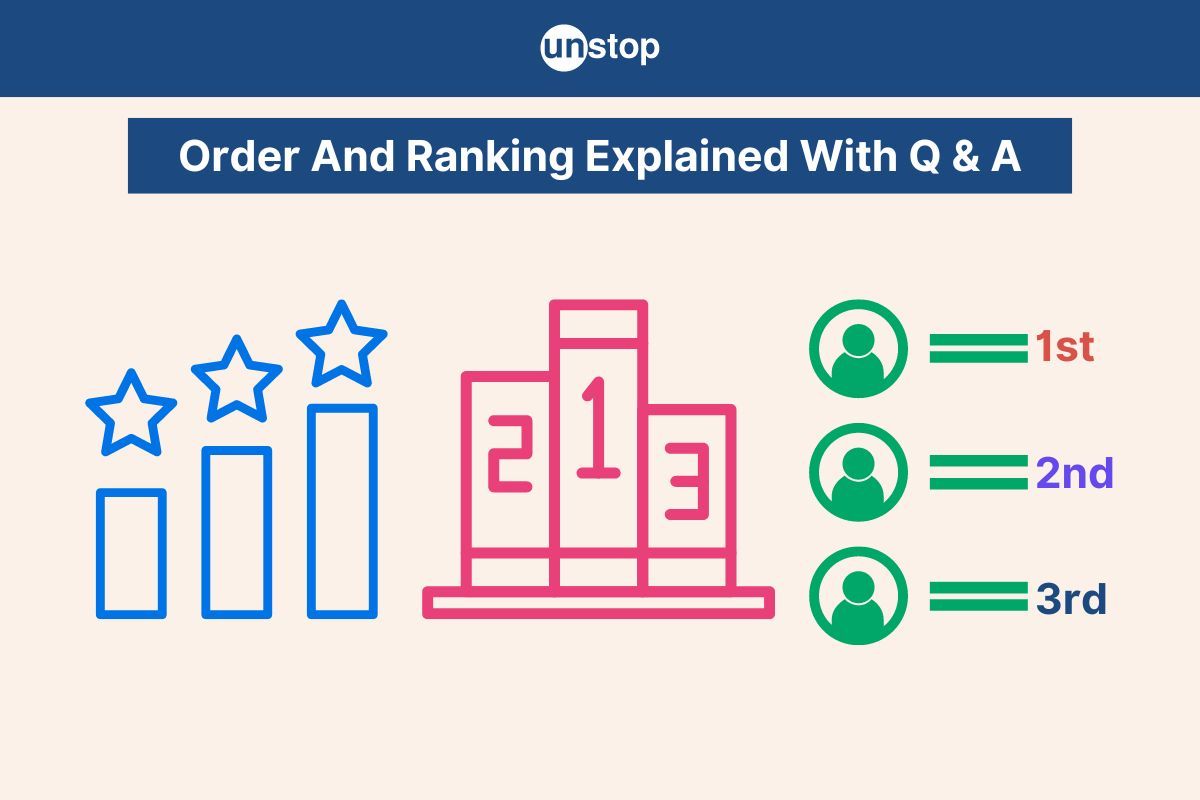- Step 1: The Groundwork
- Step 2: The Three Sections
- Step 3: Practice Makes Improvement
- The Secret Ingredient
- Understanding Basics Of Number Series
- Types Of Number Series Reasoning Questions
- Addition & Multiplication In Number Series
- Square & Cube-Based Number Series Patterns
- Missing Terms & Arranging Sequences
- Tricks & Tips For Solving Number Series
- Selected Number Series Questions With Solutions
- Frequently Asked Questions (FAQs)
- Must Know Terminologies in Blood Relation Questions
- Basic Approaches to Solve Blood Relation Questions
- Types Of Blood Relation Questions
- Tips For Solving Blood Relation Questions
- Multiple Choice Questions (MCQs) with Detailed Explanation
- Conclusion
- Frequently Asked Questions (FAQs)
- Letter Series In Logical Reasoning
- Types Of Letter Series Patterns
- Tips For Solving Letter Series Reasoning
- Best Practice Question Samples With Answers
- Conclusion
- Frequently Asked Questions (FAQs)
- Basics of Problems On Age-Related Questions
- Formula to Solve Problems on Ages-Related Questions
- Types of Age-Related Questions & Examples
- Tips & Tricks for Solving Ages Problems
- Best MCQs on Problems on ages with solved answers
- Conclusion
- Frequently Asked Questions (FAQs)
- Definition of Calendar
- Understanding Days of the Week
- What is a Leap Year?
- Concept of Odd Days in a Century
- Tips For Solving Calendar Reasoning Questions
- Best Calendar Reasoning Questions with Answers (MCQs)
- Frequently Asked Questions (FAQs)
- Basic Concepts of Clock
- Structure of a Clock
- Angle Equilavalence in Clock
- Tips For Solving Clock Questions
- Selected Clock Questions & Answers (MCQs)
- Conclusion
- Frequently Asked Questions (FAQs)
- Understanding The Concept Of Direction Sense
- Tips For Effective Problem-Solving In Direction Sense
- Practical Test Practice Questions And Answers
- Conclusion
- Frequently Asked Questions (FAQs)
- Importance Of Dice Reasoning
- Dice Numbers In Dice Reasoning
- Classification Of Dice
- Constructed Vs Deconstructed Dice
- Tricks & Tips For Solving Dice Problems
- Practice MCQs With Detailed Answers
- Conclusion
- Frequently Asked Questions (FAQs)
- Alphanumeric Series Defined
- Alphanumeric Series In Reasoning Tests
- Tips & Strategies For Solving Alphanumeric Series
- Practice Sample Questions With Detailed Answers
- Conclusion
- Frequently Asked Questions (FAQs)
- Concept Of Mirror Image Reasoning Explained
- Important Terms In Mirror Image Reasoning
- Types Of Mirror Images
- Identifying Correct Mirror Image
- Finding Clock's Mirror Image
- Tips To Solve Mirror Images
- Selected Practice Questions With Answers
- Conclusion
- Frequently Asked Questions (FAQs)
- Concept & Overview Of Input-Output
- Input-Output In Competitive Exams
- Types Of Input-Output Problems
- Strategies, Tips & Tricks For Solving Reasoning Questions
- Selected Practice Questions With Answers
- Conclusion
- Frequently Asked Questions (FAQs)
- Importance Of Finding The Odd One Out
- Tricks And Tips
- How to Find The Odd One Out?
- Solved MCQs with Detailed Explanation
- Conclusion
- Frequently Asked Questions (FAQs)
- Understanding Key Concepts
- Exploring Different Ranking Types
- Formula And Application Of Order And Ranking
- Tips For Solving Order & Ranking
- Selected Practice Questions And Answers
- Conclusion
- Frequently Asked Questions (FAQs)
- Importance Of Pipes & Cistern Aptitude
- Key Terminologies used in Pipes and Cisterns
- Pipes and Cisterns Formula with Examples
- Pipes and Cisterns Shortcut Tricks
- Tips For Solving Pipes & Cistern Problems
- Selected Questions & Answers For Practice (MCQs)
- Conclusion
- Frequently Asked Questions (FAQs)
- Key Concept in Boats and Streams
- Formulas Of Boats & Streams
- Distance & Time Formula
- Tips For Solving Boats & Streams Questions
- Selected Practice Questions With Answers (MCQs)
- Conclusion
- Frequently Asked Questions (FAQs)
- Concept of Mixture and Alligation
- Types Of Alligation Questions
- Formula for Solving Mixture & Alligation
- Tips For Solving Mixture And Alligation
- Selected Questions With Answers For Practice
- Conclusion
- Frequently Asked Questions (FAQs)
- Concepts and Definitions Related to Time and Work
- Important Time And Work Formulas
- Tricks and Tips to Solve Time & Work Questions
- Time And Work MCQs with Detailed Solution
- Conclusion
- Frequently Asked Questions (FAQs)
- What is Harmonic Progression(HP)?
- Formula to find the nth Term in Harmonic Progression
- Formula to find the Sum of the nth Term in HP
- What is Harmonic Mean?
- Harmonic Progression Solved Best MCQs
- Conclusion
- Frequently Asked Questions (FAQs)
- What is Mensuration in Maths?
- What are 2D figures in Mensuration?
- What are 3D figures in Mensuartion?
- Basic Terminologies In Mensuration
- Basic 2D Formulas in Mensuration
- Basic 3D Formulas in Mensuration
- 2D vs 3D in Mensuration
- Solved Questions With Solutions (MCQs)
- Conclusion
- Frequently Asked Questions (FAQs)
- Relationship Between Time, Speed And Distance
- Conversion Units Time, Speed And Distance
- Average & Relative Speed: Two Trains Moving in the same or opposite direction
- Solved MCQs on Time, Speed And Distance
- Conclusion
- Frequently Asked Questions (FAQs)
- What is Simplification in Maths?
- BODMAS Rule in Simplification Explained
- Simplification & Approximation Relation
- Key Terms in Simplification
- Examples Of Simplification Techniques
- Simplification Questions With Solved Answers (MCQs)
- Conclusion
- Frequently Asked Questions (FAQs)
- Height And Distance Important Terms
- Right Angled Triangle In Trigonometry
- Trigonometric Ratios
- Solved Examples For Better Understanding
- Height And Distance Applications In Trigonometry
- Height And Distance Practice Questions & Answers
- Conclusion
- Frequently Asked Questions (FAQs)
- Defining Interest Types
- Simple Interest Vs. Compound Interest
- Selected Solved Questions & Answers
- Conclusion
- Frequently Asked Questions (FAQs)
- Basic Concepts Of Profit And Loss
- Determining Selling Price
- Calculating Discounts
- Formulas For Calculating Profit And Loss
- Examples Of Profit And Loss
- Profit & Loss Questions With Detailed Solution
- Conclusion
- Frequently Asked Questions (FAQs)
- Defining Angle Of Elevation
- Key Terms Used In Angle Of Elevation
- Angle of Elevation Formula with Example
- Angle of Elevation vs. Angle of Depression
- Angle of Elevation MCQs with Answers
- Conclusion
- Frequently Asked Questions (FAQs)
- Defining HCF And LCM
- Calculation Methods Of HCF And LCM
- HCF By Prime Factorization Method
- LCM By Prime Factorization Method
- Difference Between HCF And LCM
- HCF & LCM Practice Questions With Answers
- Conclusion
- Frequently Asked Questions (FAQs)
- What is fraction and decimal?
- Understanding Decimal Fraction
- Place Value in Decimal Fraction
- Mathematical Operations with Decimal Fraction
- Practice with Solved Examples
- Summary
- Frequently Asked Questions
- All About Decimals
- All About Fractions
- How to Convert a Decimal into Fraction
- Simple vs Recurring Decimals
- Converting Recurring Decimals to Fractions
- Conversion Charts
- Practice Questions (With Solutions)
- Closing Thoughts
- Frequently Asked Questions
- What is Arithmetic Mean?
- Arithmetic Mean Formula- Ungroup Data & Group Data
- Merits of Arithmetic Mean
- Demerits of Arithmetic Mean
- Alternatives to Arithmetic Mean
- What is the Weighted Arithmetic Mean?
- Arithmetic vs. Geometric Mean
- Arithmetic Mean Application in Statistical Analysis
- Arithmetic Mean Practice Questions with Explanation
- Frequently Asked Questions
- What is Geometric Progression?
- Key Properties of Geometric Progression
- General Form Of Geometric Progression
- General Term or the Nth Term of Geometric Progression
- The sum of nth Terms of GP
- Types Of Geometric Progression
- Solved Questions and Answers of GP
- Conclusion
- Frequently Asked Questions (FAQs)
- Average in Maths
- Average Formula in Maths
- Differentiating Types of Average
- How to Calculate Average of Negative Numbers?
- Practical Applications of Averages
- Average Questions For Practice
- Frequently Asked Questions
- What is Simple Interest in Maths?
- Simple Interest Formula Explained
- Simple Interest Formula for Years, Months & Days
- Simple Interest Examples & Practice Questions
- Conclusion
- Frequently Asked Questions (FAQs)
- Defining Mathematical Ratios
- Understanding Proportions Fundamentals
- Differentiating Ratios from Proportions
- Ratio and Proportion Formulas
- Properties of Ratio and Proportion
- How to Solve Ratio and Proportion Problems
- Ratio and Proportion Problems (With Solutions)
- Summary
- Frequently Asked Questions
- What is Number in Maths?
- Types of Numbers With Example
- Real vs Complex Numbers Explored
- Basic Operations on Numbers
- Practice Questions (With Solutions)
- Frequently Asked Questions
- What is Arithmetic Progression (AP) in Maths?
- Important Terminologies in Arithmetic Progression
- Basic Terms in Arithmetic Progression
- General Form Of Arithmetic Progression Series
- Types Of Arithmetic Progression
- Solved Questions With Explanation (MCQs)
- Conclusion
- Frequently Asked Questions (FAQs)
- Understanding Basic Concept
- Importance Of Train Problems In Aptitude
- Tips To Solve Train Problems
- Selected Practice Questions & Answers
- Conclusion
- Frequently Asked Questions (FAQs)
- Definition Of Mode
- Calculating Mode For Ungrouped Data
- Calculating Mode For Grouped Data
- Bimodal, Trimodal & Multimodal Distributions
- Comparing Mean, Median & Mode
- Selected Practice Questions With Answers
- Conclusion
- Frequently Asked Questions (FAQs)
- Important Concept In Races And Games
- Calculating Time, Speed & Distance
- Importance Of Races And Games Problems
- Sample Practice Questions With Answers
- Conclusion
- Frequently Asked Questions (FAQs)
- Types Of Partnership
- Formula For Partnership Questions
- Tips To Solve Partnership Aptitude Questions
- Selected Partnership Questions (Practice MCQs)
- Conclusion
- Frequently Asked Questions (FAQs)
Order And Ranking- Concept, Formula, Practice Question And Answer

In logical reasoning sections of banking exams, questions often focus on ranking and order. These questions require arranging objects or people in a specific sequence from left to right or top to bottom.
Understanding Key Concepts
Let us study the key concept of order and ranking:
Basic Principles
Order and ranking revolve around arranging objects or information in a specific sequence based on certain criteria. It involves determining positions or hierarchies.
Order refers to the arrangement of items in a sequence, while ranking assigns positions based on specific rules or comparisons.
Significance In Logical Reasoning
Understanding order and ranking is crucial for developing logical thinking skills. It enhances one's ability to analyze information systematically and make sound judgments.
By mastering these concepts, individuals can effectively prioritize tasks, make informed decisions, and solve complex problems methodically.
Common Structures In Exams
Order and ranking questions often appear in various exams to assess analytical skills. They typically involve arranging elements based on given conditions or comparing attributes to determine positions.
Candidates may need to identify the position of a particular item in a sequence, determine relative rankings among different entities, or deduce missing information based on provided clues.

Exploring Different Ranking Types
Let us study the different ranking types in detail:
Horizontal Vs. Vertical
Horizontal rankings involve items listed side by side, like a leaderboard, where each entity holds a distinct position based on specific criteria. In horizontal lists, entities are compared directly, often in competitive scenarios.
In vertical arrangements, items are stacked based on predetermined criteria without direct competition. Vertical rankings, however, stack items on top of each other.
Numeric Vs. Categorical
Numeric ranks assign a numerical value to each item based on its performance or attributes. Categorical ranks categorize items into groups or classes without assigning specific numbers.
For instance, academic grades use numeric ranking systems to quantify performance levels. In contrast, music charts categorize songs into genres or styles rather than assigning numerical values.
Formula And Application Of Order And Ranking
The formula for calculating order and ranking depends on the context in which it's being used. In the context of arranging or ranking items, there's no single formula.
However, if you're referring to the ordinal position of an item in a sequence, you can simply use: Order= Position+1
Where:
-
Order: The ordinal position of the item.
-
Position: The position of the item in the sequence (0-indexed).
For example, if an item is in the 5th position in a sequence, its order would be 5+1=6, indicating it's the 6th item in ordinal terms.
Breaking Down Formula
One fundamental formula is the ranking reasoning formula, which calculates the position of an element in a sequence based on certain conditions.
Another crucial formula is the ranking reasoning questions formula, which helps determine the number of elements before or after a particular element.
Application
To apply these formulas effectively, consider various scenarios. For example, when solving a question where individuals are ranked based on height, use the formula to determine a person's rank given their height compared to others.
In another scenario, if you need to find out how many people are ahead of a specific individual in a queue, utilize the ranking reasoning questions formula for accurate results.
Tips For Solving Order & Ranking
Let us study some of the tips for solving order and ranking effectively:

Reasoning
Understanding the reasoning behind order and ranking problems is crucial for accurate solutions. It involves analyzing the given information logically.
When tackling these problems, apply short-cut formulas to save time and solve them efficiently. These formulas help in determining the minimum number of elements in a sequence or arrangement.
Arrangement
Pay close attention to the arrangement of elements in a row or line. Start by identifying the positions of elements, such as right ends and left ends, to establish a clear understanding.
Avoid common mistakes like misinterpreting the positions of elements along a line. Incorrectly identifying the right side or sides can lead to errors in the final solution.
Initial Analysis
Begin by carefully reading the problem to understand the directions and requirements. Identify key cub terms like "highest," "lowest," or "middle." Look for links between different elements.
Establish A Strategy
Determine the bottom line of the question - what is being asked? Break down the problem into manageable sections. Decide on an order to approach each part.
Execute Your Plan
Start with the most straightforward task or element in the problem. Work through each interchange, ensuring accuracy before moving on. Maintain a clear state of your progress.
Evaluate & Adjust
Check your work as you go along, verifying each step's correctness. If you encounter difficulties, revisit your initial strategy and make necessary adjustments.
Selected Practice Questions And Answers
Practice is key to mastering the order and ranking concepts. Here are selected sample questions with answers to reinforce your reasoning ability in order and ranking questions:

Question 1: In a race of 6 people, A finished before B but behind C. D finished before E but behind B. Who finished last?
a) A
b) B
c) C
d) E
Answer: d) E
Explanation: From the given conditions, the order is C - A - B - D - E. So, E finished last.
Question 2: In a class of 30 students, R is 10th from the top; what is R's rank from the bottom?
a) 20th
b) 21st
c) 22nd
d) 23rd
Answer: b) 21st
Explanation: In a class of 30 students, if R is 10th from the top, then R would be 30 - 10 + 1 = 21st from the bottom.
Question 3: In a queue of 50 people, M is 20th from the front; what is M's position from the back?
a) 30th
b) 33rd
c) 32nd
d) 31st
Answer: d) 31st
Explanation: M's position from the back of the queue = Total number of people in the queue - M's position from the front of the queue + 1
M's position from the back of the queue = 50 - 20 + 1= 30 + 1 = 31.
Question 4: In a competition of 5 participants, P scored more than Q but less than R, and S scored less than T but more than P. Who came second?
a) P
b) Q
c) R
d) S
Answer: d) S
Question 5: In a marketing class at an MBA program, six students – A, B, C, D, E, and F – are seated in a row for a group discussion. The seating arrangement is based on their names in alphabetical order from left to right with the following conditions: B is seated somewhere to the right of A. D is seated exactly in the middle of the row. F is seated immediately to the right of E. C is not seated at either end of the row. E is not seated next to A.
Based on the information provided, who is seated at the far right end of the row?
a) B
b) C
c) E
d) F
Answer: a) B
Explanation: C, A, D, E, F, B.
Question 6: In a row of 20 students, Student P is 15th from the front. What is Student P's position from the back?
a) 5th
b) 6th
c) 7th
d) 8th
Answer: b) 6th
Explanation: In a row of 20 students, if Student P is 15th from the front, then Student P would be 20 - 15 + 1 = 6th from the back.
Question 7: In a competition of 7 participants, participant X scored more than Y but less than Z, and participant W scored less than V but more than X. Who came third?
a) W
b) X
c) Y
d) Z
Answer: b) X
Explanation: From the given conditions, the order is Z - X - V - W - U - T - Y. So, X came third.
Question 8: In a friendly coding competition among five friends – Lara, Max, Neil, Olivia, and Peter – the final rankings are announced based on their performance. The following conditions are known: Max finished higher than Lara but lower than Neil. Olivia did not finish last. Peter finished immediately after Lara. Based on the information provided, who finished first in the competition?
a) Lara
b) Max
c) Neil
d) Olivia
Answer: c) Neil
Explanation: Neil is the only person who is explicitly mentioned as finishing higher than others (Max and implicitly higher than Lara and Peter due to the placement of Max and the consecutive finish of Peter after Lara), and since Olivia did not finish last, she can't implicitly finish first based on the condition that Max is lower than Neil.
Question 9: In a row of 25 people, person M is 20th from the front. What is person M's position from the back?
a) 5th
b) 6th
c) 7th
d) 8th
Answer: b) 6th
Question 10: At the end of a chess tournament, the final ranking is announced. If Roger is ranked higher than David but lower than Patrick, and Sarah is ranked lower than David, who is ranked the highest?
a) Roger
b) Patrick
c) David
d) Sarah
Answer: b) Patrick
Conclusion
You've gained a solid grasp of order and ranking concepts, explored various types, mastered formulas, learned essential rules, followed a step-by-step guide, enhanced skills with examples, received practical tips, and practised with sample questions.
Now, it's time to put all this knowledge into action. Keep practising regularly to sharpen your skills further and confidently tackle ranking problems. Remember, consistency is key to mastering any skill.
Quiz Time To Test Your Mind
Frequently Asked Questions (FAQs)
1. What are the key concepts to understand about order and ranking?
To excel in order and ranking, grasp fundamental concepts like relative positions, sorting criteria, and the importance of rankings in various contexts.
2. How can one explore different types of ranking effectively?
Dive into diverse ranking types such as numerical, categorical, or comparative to broaden your understanding and analytical skills.
3. What formulas should one master for effective ranking calculations?
Master essential ranking formulas like Rank = (n+1) - Position to efficiently solve problems and analyze data sets accurately.
4. What rules are crucial for effective problem-solving in order and ranking scenarios?
Follow essential rules such as understanding the criteria, staying organized, double-checking results, and practicing consistently for improved problem-solving skills.
5. How can one enhance their order and ranking skills using solved examples?
Leverage solved examples to deepen comprehension, identify patterns, and refine strategies for tackling complex order and ranking challenges effectively.
Instinctively, I fall for nature, music, humor, reading, writing, listening, traveling, observing, learning, unlearning, friendship, exercise, etc., all these from the cradle to the grave- that's ME! It's my irrefutable belief in the uniqueness of all. I'll vehemently defend your right to be your best while I expect the same from you!
Login to continue reading
And access exclusive content, personalized recommendations, and career-boosting opportunities.
Subscribe
to our newsletter
















Comments
Add comment